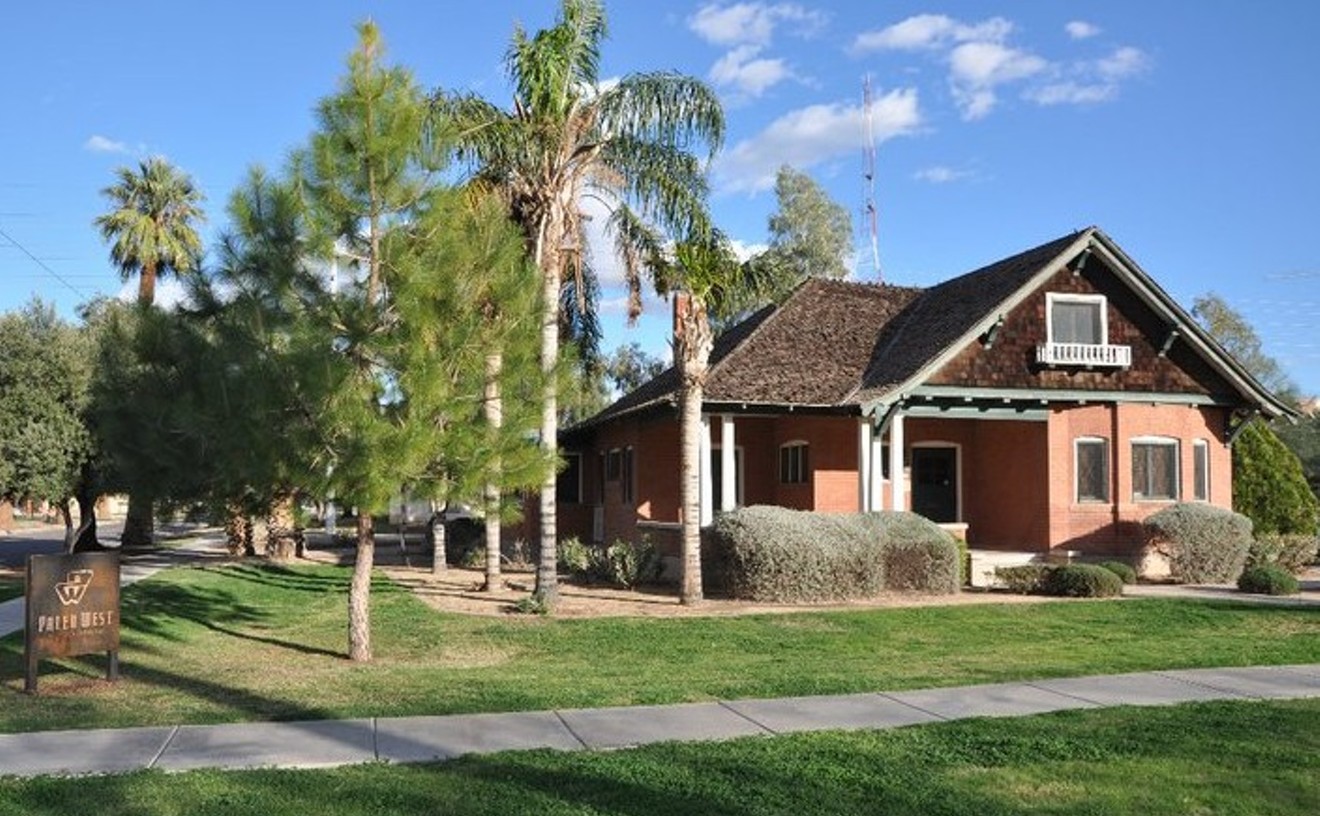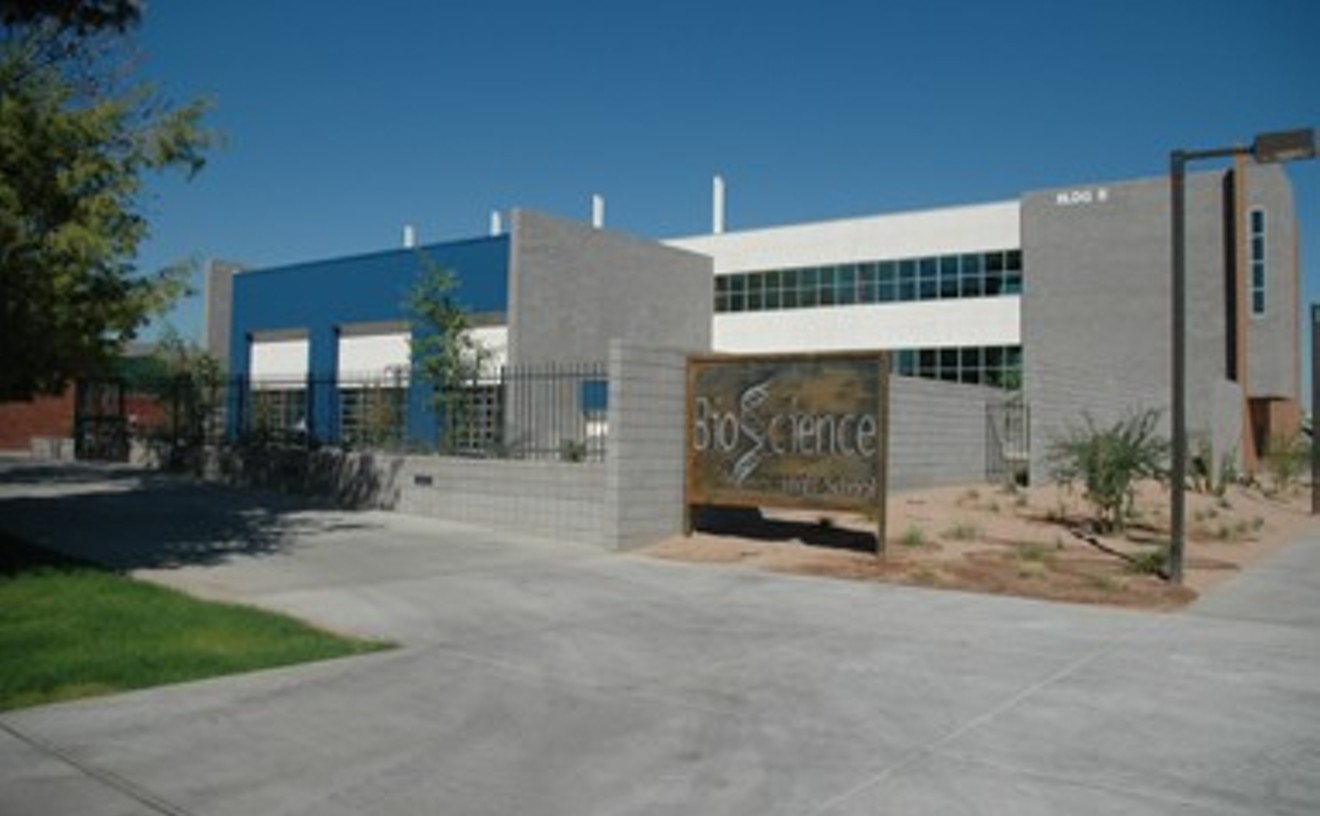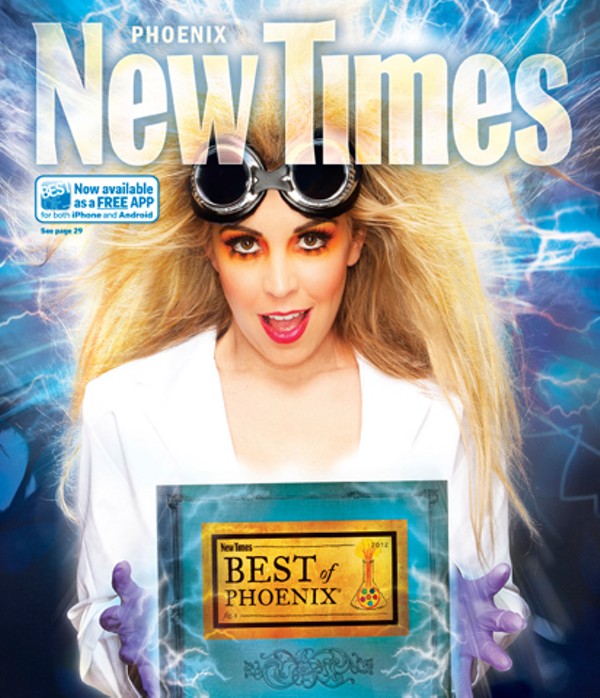Researchers at ASU helped throw the Mars Odyssey orbiter into space way back in 2001. One of the major pieces of equipment they are responsible for was the THEMIS (Thermal Emission Imaging System). The THEMIS is much more than a super-expensive digital camera. It's a super-expensive digital camera that can take pictures of the infrared spectrum.
Looking into the infrared means that the Mars Odyssey probe is able to see things from orbit that a regular camera could not. It can spot things like the residual heat from deep geothermal systems or compare types of rocks just by how they retain or reflect heat from the sun. Superficially, this just means it sends back a bunch of black-and-white photos, but its real value becomes clear when you try to do something a little crazy. Like land a nuclear-powered Cooper Mini on the surface of Mars using a rocket skycrane. Before the Curiosity Mars rover even neared the Red Planet, THEMIS sat in high orbit scoping out landing sites for the probe. From those pictures, scientists were able to help pick out an ideal landing site along the Gale Crater for the rover. The data they collected allowed them to look even more closely at the surface, picking a spot that appeared to be free of massive rocks. And, given the success of Curiosity, it looks like THEMIS chose well.Best Local Indiana Jones
Todd Bostwick, PaleoWest Solutions in Archaeology

For those who say Arizona has no history, Todd Bostwick would like a word with you. The senior research archeologist at PaleoWest Archaeology and executive director of the Verde Valley Archaeology Center in Camp Verde, Bostwick has been working in the field for more than 40 years. So he's got some history — including multiple degrees and a résumé that is, no joke, 12 pages long. How does a guy acquire such an extensive portfolio in a field that would drive the not-so-meticulous insane? Well, unlike most of us, Bostwick has had a passion for his current field since childhood. Long before the days of Indiana Jones, Bostwick was digging up century-old toys he found in the yard of his parents' Nevada home.
Lucky for Phoenix, Bostwick enjoys sharing his archeological finds (his specialties are rock art and ancient astronomy) with others, even going so far as to do house calls (assuming you've found ancient treasures in your backyard). Alongside his more technical published works, Bostwick has published informational books that are more conducive to the everyday amateur scientist, including Landscape of the Spirits: Hohokam Rock Art at South Mountain Park and Beneath the Runways: Archaeology of Sky Harbor International Airport.And though he recently retired from the city of Phoenix after serving as city archaeologist for more than 20 years, Bostwick admits he'll never truly stop digging. See a slideshow here.- 649 N. 3rd Ave., Phoenix, 85003 Map
- 602-261-7253
- www.paleowest.com
Best Brain Surgeon
Dr. Robert F. Spetzler at Barrow Neurological Institute

We hope to never suffer any cerebral damage in our lifetime, but we do know the right guy for the job, if the worst happens. (Come to think of it, we should probably write down his name and tape it to the fridge in case of said damage.) Dr. Robert Spetzler is director of the Barrow Neurological Institute at St. Joseph's Hospital, where he and his team lead the nation in the number of brain surgeries performed and brain surgeons trained. A celebrity in the medical world, Dr. Spetzler specializes in aneurysms, skull base tumors, and other brain malformations and has operated on nearly 6,000 brain aneurysms in his career, which is more than anyone else in the world.
In 1986, Dr. Spetzler took on the role of director at Barrow and banded together a group of skilled neurosurgeons to form Barrow Neurological Associates. He helped create a residency program that medical students from across the country aspire to make, at a hospital that patients all over the globe seek access to. He also was a key player in developing a life-saving surgical technique (the cardiac standstill) for safely removing aneurysms, as well as new surgical tools, including the 3D microscope. The man's busy. So while it's nice to know he's there if we need him, if you foresee yourself engaging in any act of physical stupidity, we suggest you take his advice and "helmet your head." See a slideshow here.- 350 W. Thomas Rd., Phoenix, 85013 Map
- 602-406-6281
- www.barrow.org
Best Way to Learn How to Make Your Garden Really Grow
Maricopa County Master Gardener Program
If you've ever tried to plant something in Phoenix, you've probably realized it takes a little more than "just add water" to get something to grow (or, harder yet, survive). Luckily, there are teaching professionals like Carol Stuttard to help you contrary Marys get your gardens up and growing. Among her credentials (which include certified desert landscape garderer at the Desert Botanical Garden and president of the Scottsdale Community Garden Club), Stuttard is a Maricopa County master gardener.
You can be one, too.The Maricopa County Master Gardener program is part class, part volunteer service that digs into the science of horticulture as it applies to the desert. Master gardeners complete the program with a thorough knowledge of the what, where, when, and how of growing plants in Phoenix. They then take that knowledge and use it to better the community by contributing 50 hours or more to program-approved services such as managing gardening phone lines and providing educational programs to adults, students, and children.Troubled gardeners not in the program can even take their plants, on assigned days, to the one of the several master gardener office locations for what the program calls their Diagnostic Clinic. Of course, the master gardener program doesn't have to be a one-time deal. Program graduates can maintain their master gardener status by fulfilling 12 hours of additional training and 25 hours of addition service each year. It's the green gift that keeps on giving in a too-often crunchy-brown town. See a slideshow here.- 4341 E. Broadway Rd., Phoenix, 85040 Map
- 602-827-8200
- www.ag.arizona.edu/maricopa/garden
Best School for a Mad Scientist in Training
Bioscience High School

Finding a good public school can be a challenge, but it can be especially challenging if your child stays up late watching reruns of Bill Nye the Science Guy and Dexter's Laboratory. If your child has been bitten by the science bug, it might be prudent to enroll him or her in a high school that has science in the name.
Bioscience High School is a magnet school with a serious focus on education in the life sciences. In addition to the standard public school curriculum, it also exposes students to opportunities they are unlikely to find anywhere else in the Valley. For instance, the school has received a hefty grant from Intel to help build a biofuel program. Students have filled several nearby vacant lots with rows upon rows of sunflowers. These sunflowers are harvested for their seeds which are pressed for oil. These oils are then processed into biofuel, which powers an alternative-fuel vehicle designed and built by the students themselves. Beyond that, the school has an active and competitive robotics team. Besides, you know that a school is serious about the biological sciences when it has a desert tortoise named Isis and a mascot named the Double Helix Dragons. Bioscience High School is part of the Phoenix Union High School District and has open enrollment for anyone within its geographical boundaries. Students living outside of those boundaries can still enroll on a space-available basis.- 512 E. Pierce St., Phoenix, 85004 Map
- www.phoenixunion.org/bioscience
Best Use of Technology to Make Being Lazy Even Easier
AdSkip
TiVo and other DVR technology has been a boon for couch potatoes. Gone are the days when humanity was actually forced to watch commercials or plan their lives around watching specific shows at specific times. But DVRs have one serious drawback: If you are watching something live and it goes to commercials, what do you do while you wait for your show to come back on?
The answer is AdSkip, an award-winning prototype device developed by a trio of ASU engineering majors — Anthony Thau, Chase Parenteau, and Chris McBride — and submitted to an Intel-sponsored competition in Shanghai. (They won second place in their category.) AdSkip uses complex algorithms to detect when a TV show is about to cut to commercial and instantly changes the channel to something better. That "something better" could be another show or even the Internet. When your show returns from its commercial break, AdSkip pops the digital clutch and drops you back into the action. Sure, humanity has been doing this for decades by means of the "television remote control," but this is the 21st century! There is absolutely no reason why you should have to push a physical button to get this kind of result.Best Animal Testing in the Name of Animals
Canine Hereditary Cancer Consortium at the Translational Genomics Research Institute (TGen)
Animal testing is generally a concept that raises the hackles of animal lovers everywhere. However, some testing doesn't just help people; it also helps our canine friends. Researchers at TGen are busy collecting thousands of samples from dogs who have developed cancer in the hopes of figuring out exactly which genetic factors lead to cancer.
Research to date indicates that the chances of getting cancer depend in no small part on whether you inherited the wrong genes from your parents. But due to the complexity of genetics and other factors, we have not yet managed to isolate exactly which genes make people more susceptible to cancer. It's very likely that cancer isn't triggered by one bad gene but rather several genes malfunctioning in concert with one another. TGen is collecting specimens from purebred dogs because their highly selective breeding means that there is low genetic variability between dogs of the same breed. If you've ever played a "spot the differences" game in the newspaper, you have a rough idea of what scientists are trying to accomplish. The fewer differences there are between samples, the easier it is to figure out which differences cause cancer. While this obviously is good news for dogs, it's also good news for us, because whatever we unravel from their genetic code might very well apply to us.- 445 N. 5th St., Phoenix, 85004 Map
- 602-343-8400
- www.tgen.org
Best (Creative) Use of Natural Light
James Turrell
Internationally acclaimed artist James Turrell isn't easy to find. He's often completing commissions for his sky spaces for private collectors, museums, and public establishments around the country. But Turrell, who's based in Arizona, recently spent a long time on the Arizona State University Campus in Tempe envisioning his latest project. Off of Rural Road, just behind the light-rail stop, is a (still-unnamed, as of press time) installation. Turrell enlisted local architect Will Bruder to help him build a public skyspace that allows viewers to see the sky through a well-lit frame. The concept is hard to describe, but if you step inside any of Turrell's structures and view his lit experiments, you'll understand his fascination with natural light (and you'll never again see the sky as just blue). He finds ways to play with light paths and the changing colors of the sky to create spaces including Knight Rise at Scottsdale Museum of Contemporary Art and his very mysterious (and not yet open to the public) project inside of Roden Crater.
Best Fire Man
Dr. Stephen Pyne
This year, the Gladiator, Bull Flat, Elwood, and Sunflower fires burned more than 3,000 acres throughout Arizona, and no one was watching more closely than Dr. Stephen Pyne. Pyne's spent 15 years as a wildland firefighter and now is an expert on the history and management of fire, which he teaches at Arizona State University. He also recognizes the irony in his name and what he loves to do — chase, study, and write about fires. Pyne grew up in Phoenix. He went to Brophy Prep and left right after graduation to join the forest fire crew at the North Rim of the Grand Canyon; he says he returned for 15 seasons between studying at Stanford University and the University of Texas at Austin and completing MacArthur, Fulbright, and two National Endowment for the Humanities fellowships.
And after all the awards and interviews, book releases, and recognition, he still answers phone calls and e-mails from around the world to explain wildfire phenomena. This year, over one recent weekend, he shared the reasoning behind names of certain fires, which typically are determined by either the Forest Service, whose employees only name fires after nearby geographic places, or the National Park Service (where Pyne worked), whose employees name them after natural landmarks, popular culture, and particularly memorable girlfriends.Best Meteorologist
Ken Waters, National Weather Service
We aren't giving this guy the nod for best weather guy simply because he's got the most awesome name we've heard for a weatherman in the desert. Ken Waters has a cool title, too: warning coordination meteorologist for the National Weather Service in Phoenix. He collects and interprets data from satellites and radar that allows him to predict when the next haboob is rolling into town. Waters studied weather for years before taking this job; he also served in the U.S. Air Force as a "weather officer." See a video of Waters in action.





